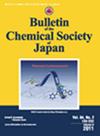Three-type Precursors for Low-Temperature Solution-Processed Void-and-Crack-Free CuI Films: Comparison of Electrical Conductivities and Optical Transparency
IF 3.8
3区 化学
Q2 CHEMISTRY, MULTIDISCIPLINARY
引用次数: 0
Abstract
Copper iodide (CuI) is a wide-bandgap (colorless) p-type semiconductor with a high Seebeck coefficient. Although CuI is promising for fabricating transparent thermoelectric devices and hole-transfer layers of solar cells, the insolubility in common solvents due to 3-dimensional coordination networks has been a drawback to constructing low-temperature solution-processed thin films. Moreover, it is challenging to fabricate void-and-crack-free CuI thin films through a convenient spin-coating process. In limited solvents of acetonitrile and diethyl sulfide, CuI is dissolved by forming soluble CuI complexes; however, void-and-crack-free CuI thin films have never been prepared. In this study, we report that CuI-alkanolamine complexes are soluble in alcohols and the spin-coated complexes undergo thermal decomposition to a CuI thin film at moderately low temperatures until 150 °C. We discover that the CuI-alkanolamines show different properties such as solubility and melting/decomposition temperatures depending on their structures. Specifically, by using 1-amino-2-propanol, we obtain void-and-crack-free and transparent CuI thin films with controlled thicknesses of >50 nm. The conductivity, carrier density, mobility, and Seebeck coefficient of the CuI thin film are 9.35 S·cm-1, 6.38×1019 cm-3, 0.96 cm2·V-1·S-1, and 192 µV・K-1, respectively.低温溶液加工的无空隙无裂缝 CuI 薄膜的三种前驱体:导电性和光学透明度的比较
碘化铜(CuI)是一种具有高塞贝克系数的宽带隙(无色)p 型半导体。虽然 CuI 有望用于制造透明热电设备和太阳能电池的空穴传输层,但其三维配位网络导致的在普通溶剂中的不溶性一直是构建低温溶液加工薄膜的一个缺点。此外,通过便捷的旋涂工艺制作无空隙和裂缝的 CuI 薄膜也具有挑战性。在乙腈和硫化二乙烷等有限的溶剂中,CuI 通过形成可溶性 CuI 复合物而溶解;然而,无空隙和裂缝的 CuI 薄膜却从未制备出来。在这项研究中,我们发现 CuI-烷醇胺络合物可溶于醇类,并且旋涂络合物在 150 °C 之前的中等低温下会发生热分解,生成 CuI 薄膜。我们发现,CuI-烷醇胺因其结构不同而显示出不同的特性,如溶解度和熔化/分解温度。具体来说,通过使用 1-氨基-2-丙醇,我们获得了无空隙、无裂纹、透明的 CuI 薄膜,厚度控制在 50 nm。CuI 薄膜的电导率、载流子密度、迁移率和塞贝克系数分别为 9.35 S-cm-1、6.38×1019 cm-3、0.96 cm2-V-1-S-1 和 192 µV・K-1。
本文章由计算机程序翻译,如有差异,请以英文原文为准。
求助全文
约1分钟内获得全文
求助全文
来源期刊
CiteScore
6.40
自引率
5.00%
发文量
194
审稿时长
3-8 weeks
期刊介绍:
The Bulletin of the Chemical Society of Japan (BCSJ) is devoted to the publication of scientific research papers in the fields of Theoretical and Physical Chemistry, Analytical and Inorganic Chemistry, Organic and Biological Chemistry, and Applied and Materials Chemistry. BCSJ appears as a monthly journal online and in advance with three kinds of papers (Accounts, Articles, and Short Articles) describing original research. The purpose of BCSJ is to select and publish the most important papers with the broadest significance to the chemistry community in general. The Chemical Society of Japan hopes all visitors will notice the usefulness of our journal and the abundance of topics, and welcomes more submissions from scientists all over the world.

 求助内容:
求助内容: 应助结果提醒方式:
应助结果提醒方式:


